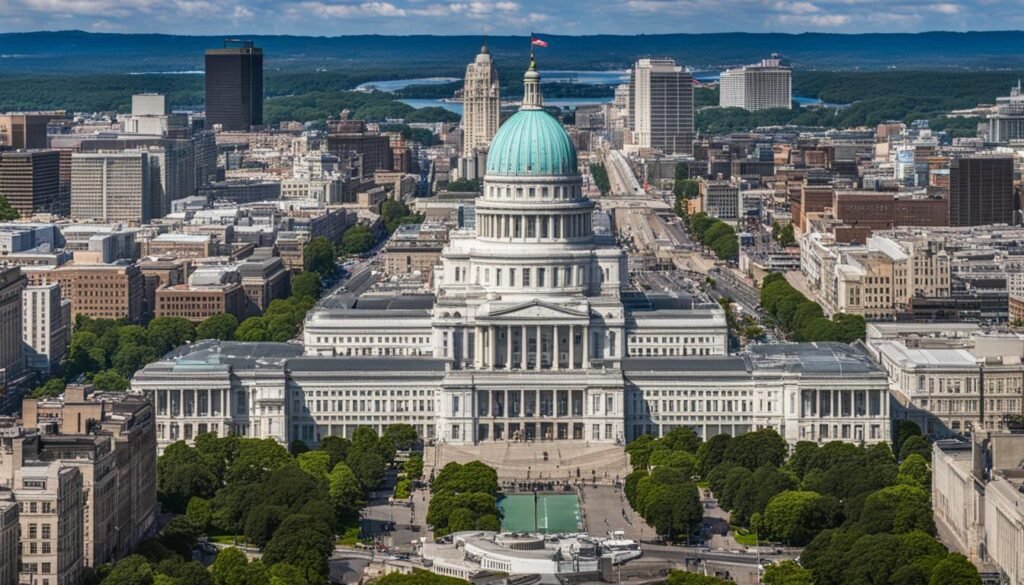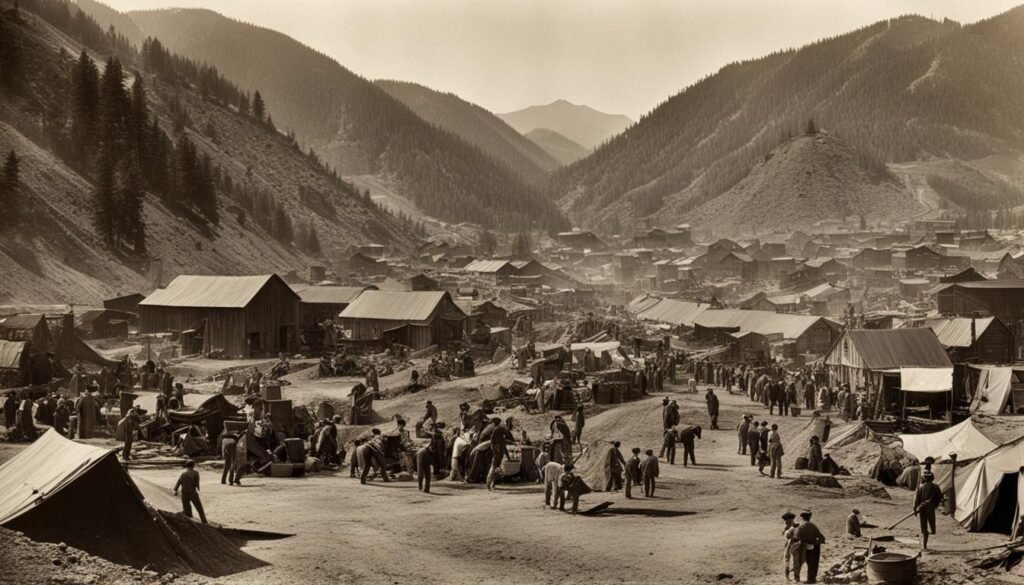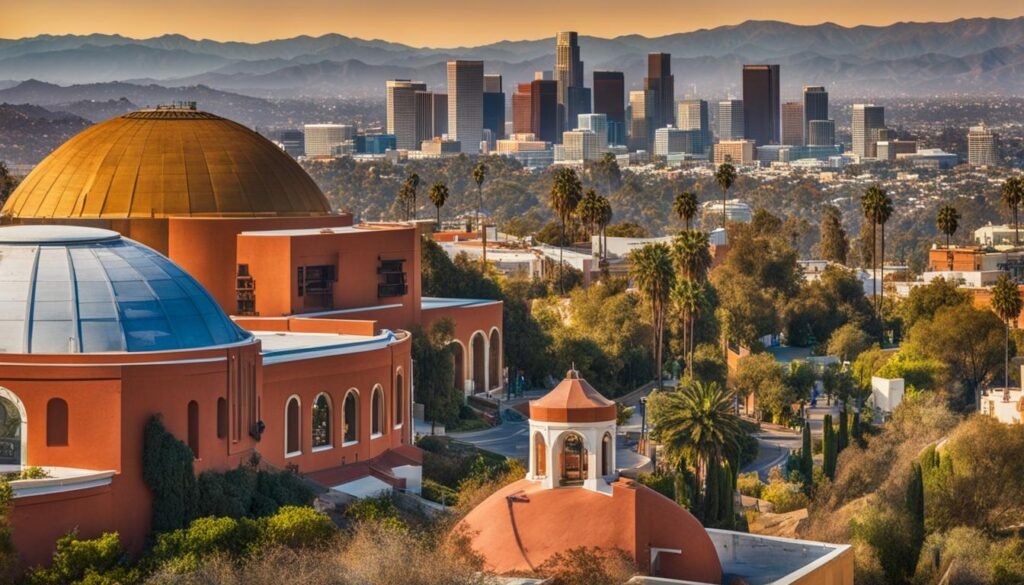Have you ever wondered what the capital of California is? Well, the answer is Sacramento! Located in the northern part of the state, Sacramento is where you’ll find the seat of the California Legislature and the Governor of California.
Choosing the capital wasn’t an easy decision. Several cities, including Monterey, San Jose, Vallejo, and Benicia, served as temporary capitals before Sacramento was designated as the permanent capital in 1854. Since then, Sacramento has played a crucial role in California’s governance and development.
As the political center of the state, Sacramento is not only where important decisions are made but also home to various state government offices and agencies. It’s where the California Legislature holds its sessions, and where the Governor of California resides. The city’s significance goes beyond politics, with historical landmarks and state symbols that represent California’s rich heritage.
Key Takeaways:
- The capital of California is Sacramento.
- Sacramento became the permanent capital in 1854.
- The city is home to the California Legislature and the Governor of California.
- Sacramento has historical landmarks and state symbols that represent California’s identity.
- Choosing Sacramento as the capital was a significant decision in California’s history.
History of the Capital of California
Sacramento has a rich history as the capital of California. It was first established as a city in 1849 and quickly became an important center for the California Gold Rush. The city played a significant role during the early years of California’s statehood, serving as the political and economic hub of the state. Sacramento was chosen as the permanent capital in 1854 and has remained the capital ever since. The city has witnessed many historical events and has played a crucial role in shaping the development of California.
During the California Gold Rush in the mid-19th century, Sacramento experienced a massive influx of settlers from around the world. The city’s strategic location at the confluence of the Sacramento and American Rivers made it a vital transportation hub for people seeking their fortunes in the gold fields. As a result, Sacramento quickly grew in population and importance, attracting both fortune seekers and entrepreneurs.
As Sacramento continued to prosper, it became the epicenter of commerce and trade in California. The city’s proximity to the Sierra Nevada Mountains and the fertile Central Valley contributed to its economic success. In addition to being a hub for the gold rush, Sacramento emerged as a major agricultural center, supplying food and resources to the growing population of the state.
The decision to establish Sacramento as the capital in 1854 marked a turning point in the city’s history. Prior to that, several other cities, including Monterey, San Jose, Vallejo, and Benicia, had served as temporary capitals. However, Sacramento’s central location and its growing influence made it the ideal choice for the permanent capital.
The city of Sacramento has witnessed numerous pivotal events in California’s history. It played a role in the Transcontinental Railroad, serving as the western terminus of the Central Pacific Railroad. It also experienced significant growth and development during the late 19th and early 20th centuries, becoming a center for government, commerce, and culture.
Today, Sacramento remains the capital of California and continues to thrive as a dynamic metropolitan area. Its rich history and vibrant present make it a destination for residents and visitors alike. The city’s museums, historical landmarks, and diverse cultural scene showcase its enduring legacy as the capital of the Golden State.
Significance of Sacramento as the Capital of California
Sacramento holds tremendous significance as the capital of California. Not only is it the political capital, but it is also the center of the state government. This bustling city is where the California Legislature holds its sessions and where the Governor of California resides. With its numerous state government offices and agencies, Sacramento serves as a crucial administrative center.
Sacramento’s historical importance is undeniable. It was in this very city that the first U.S. flag was raised in California, marking a pivotal moment in the state’s history. Additionally, Sacramento played host to the first Constitutional Convention in 1849, shaping the early governance of California.
This vibrant city is home to several significant California state symbols. One such symbol is the iconic California State Capitol building, which stands as a testament to the state’s political power. The California State Flag, with its distinctive bear and star, is another emblem that represents the state’s heritage. Furthermore, the California State Seal, with its depiction of a miner and a sailing ship, encapsulates the history and values of California.
Sacramento’s Role in California’s Early Governance
Sacramento played a crucial role in California’s early governance, establishing itself as the state’s capital city during its formative years. In 1849, Sacramento hosted the first Constitutional Convention, which laid the groundwork for California’s statehood. While San Jose initially served as the capital, it was later determined that Sacramento was a more suitable location.
As the state’s capital, Sacramento provided a central hub for political activities and decision-making. The city’s strategic position along the Sacramento and American Rivers made it an ideal location for the state legislature. Sacramento quickly grew to become the focal point of California’s government, hosting important legislative sessions and administrative functions.
Today, Sacramento continues to serve as the capital of California, playing a vital role in the state’s governance. It is where the California Legislature convenes and where the Governor of California resides. The city’s historical significance and ongoing involvement in state affairs make it an integral part of California’s identity and governance.
The Growth and Development of Sacramento as the Capital
Since becoming the capital of California, Sacramento has experienced remarkable growth and development. This vibrant city has expanded both in terms of population and infrastructure, transforming into a thriving urban center. The strategic significance of Sacramento as the capital has led to the development of essential government facilities, including the magnificent California State Capitol building.

Sacramento’s growth as the capital has not only focused on administrative buildings but has also embraced the establishment of numerous cultural and educational institutions. These institutions have enriched the city’s cultural landscape, creating a dynamic and intellectually stimulating metropolitan area.
Today, Sacramento has emerged as a popular tourist destination, attracting visitors from across the United States and around the world. Its distinct charm lies in its historical landmarks, captivating museums, and diverse recreational opportunities. Visitors can explore the rich history of the capital, delve into world-class exhibits, or enjoy the scenic beauty of the surrounding region.
Facts about the Capital of California:
- Sacramento, located in the state of California, serves as its capital.
- The city has experienced significant growth and development since becoming the capital.
- Government facilities, including the California State Capitol building, have been developed to support the city’s administrative functions.
- Sacramento is home to numerous cultural and educational institutions, contributing to its vibrant metropolitan atmosphere.
- The city has become a popular tourist destination, attracting visitors with its historical landmarks, museums, and recreational opportunities.
As the capital of California, Sacramento holds a significant place in shaping the cultural, economic, and historical identity of the state. Its growth, development, and vibrant atmosphere make it an integral part of California’s story.
Sacramento’s Cultural and Economic Significance
Sacramento, as the capital of California, holds immense cultural and economic importance. The city is home to several prominent cultural institutions that showcase the history, art, and culture of the state. One such institution is the Crocker Art Museum, which features an extensive collection of American and European art spanning from the Gold Rush era to the present day. Another notable museum in Sacramento is the California Museum, which highlights the diverse heritage and achievements of Californians through interactive exhibits and educational programs.
The California State Railroad Museum is another cultural gem in Sacramento, preserving and interpreting the state’s railroad history. Its exhibits allow visitors to delve into the past and experience the pioneering spirit that shaped California’s transportation system.
The economic significance of Sacramento stems from its status as the seat of the California state government. With various governmental offices and agencies based in the city, Sacramento serves as a hub for administrative, legislative, and regulatory activities. The presence of the California governor and the state legislature contributes to the city’s economic growth by providing employment opportunities and attracting businesses that support the functioning of the government.
Furthermore, Sacramento’s position as a center for education, healthcare, and technology further enhances its economic vitality. The city is home to several renowned educational institutions, including California State University, Sacramento, which offers a wide range of academic programs and contributes to the intellectual capital of the region. Sacramento is also known for its world-class healthcare facilities, attracting medical professionals and patients from across the state.
Additionally, Sacramento has emerged as a burgeoning technology hub, with numerous startups and established tech companies choosing the city as their base. The city’s central location in the state, coupled with its proximity to major transportation routes and airports, makes it an attractive location for businesses seeking to establish a presence in California.
The Vibrant Cultural Scene
Sacramento’s cultural significance extends beyond its museums and institutions. The city is known for its vibrant arts and music scene, with numerous theaters, galleries, and live music venues. The Sacramento Music Festival brings together musicians from various genres, attracting music enthusiasts from near and far.
Moreover, Sacramento takes pride in its diverse culinary offerings. The city boasts an array of restaurants that cater to every palate, from farm-to-fork dining experiences showcasing local produce to international cuisines that reflect the multicultural fabric of California.
A Thriving Lifestyle and Recreation
Residents and visitors to Sacramento can enjoy a high quality of life with access to numerous parks, outdoor recreational areas, and biking trails. The city’s location near the confluence of the Sacramento and American Rivers provides ample opportunities for water-based activities such as boating, fishing, and kayaking.
Furthermore, Sacramento hosts various annual events and festivals, including the California State Fair, which celebrates the state’s agricultural heritage and offers entertainment, food, and exhibits that captivate both locals and tourists alike.
By embracing its cultural heritage and nurturing its economic potential, Sacramento has established itself as a dynamic and thriving city that exemplifies the spirit of California. Its rich history, diverse cultural landscape, and economic prowess make it an integral part of the Golden State’s collective identity.
Sacramento’s Contribution to California’s Identity
Sacramento, as the capital of California, has played a vital role in shaping the state’s identity. It represents the seat of government and symbolizes California’s political power. The city’s historical landmarks, such as the California State Capitol building and the Sacramento Custom House, serve as reminders of California’s past and its journey to statehood. These iconic symbols stand as testaments to the significant events and milestones that have shaped the Golden State.
Moreover, Sacramento’s cultural institutions contribute to fostering a strong sense of Californian identity. Museums like the Crocker Art Museum and the California Museum showcase the state’s rich history, art, and diverse culture. These institutions provide valuable insights into the foundation and growth of California, serving as important educational and cultural resources for residents and visitors alike.
In addition to its historical and cultural significance, Sacramento’s vibrant community further enhances its role in representing California. The city is home to a diverse population, reflecting the state’s melting pot of cultures and backgrounds. Its cosmopolitan atmosphere and welcoming spirit create a dynamic environment where people from all walks of life can come together, contributing to the inclusivity and diversity that define California.

By virtue of being the capital and a hub of activity, Sacramento embodies the values, aspirations, and ideals of California. It serves as a beacon of progress, innovation, and opportunity, fostering a sense of pride among its residents and the broader Californian community. Sacramento’s contribution to California’s identity is both significant and enduring, and it continues to play a crucial role in shaping the narrative of the Golden State.
Conclusion
In conclusion, Sacramento is the capital of California. With its rich history, cultural significance, and economic importance, this vibrant city has played a vital role in the governance and development of the state. As the political center, Sacramento serves as the seat of the California Legislature and the Governor of California, where important decisions are made that shape the future of the state.
Furthermore, Sacramento’s historical landmarks, such as the iconic California State Capitol building and the Sacramento Custom House, stand as proud symbols of California’s past and its journey to statehood. The city’s cultural institutions, state symbols, and diverse community contribute to fostering a sense of Californian identity and pride.
As we conclude our exploration of the capital of California, let us recognize the ongoing significance of Sacramento. It remains an essential pillar of California’s story, continuously contributing to the state’s growth, prosperity, and overall identity. Sacramento stands tall as a shining example of the dynamic, diverse, and resilient spirit that defines the Golden State.
FAQ
What is the capital of California?
The capital of California is Sacramento.
Where is Sacramento located?
Sacramento is located in the northern part of California, at the confluence of the Sacramento and American Rivers.
What is the history of Sacramento as the capital of California?
Sacramento was chosen as the capital in 1854 after several other cities served as temporary capitals. It became the permanent capital and has since played a significant role in shaping the development of California.
Why is Sacramento significant as the capital of California?
Sacramento is not only the political capital but also the center of the state government. It is home to the California Legislature, the Governor of California, various state government offices, and agencies.
What role did Sacramento play in California’s early governance?
Sacramento served as the capital city during the formative years of the state, hosting the first Constitutional Convention in 1849. It became the permanent capital after San Jose was deemed insufficient.
How has Sacramento grown and developed as the capital?
Sacramento has experienced significant growth and development since becoming the capital, expanding in both population and infrastructure. It has become a thriving urban center with government facilities and cultural and educational institutions.
What is the cultural and economic significance of Sacramento as the capital?
Sacramento is home to various cultural institutions and benefits economically from the presence of the state government. It is a hub for education, healthcare, and technology, contributing to its overall economic vitality.
How has Sacramento contributed to California’s identity?
As the capital, Sacramento represents the seat of government and symbolizes the state’s political power. Its historical landmarks, cultural institutions, state symbols, diverse population, and cosmopolitan atmosphere contribute to fostering a sense of Californian identity.







